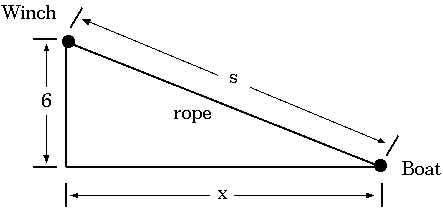
Example 1 A boater has his boat tied to the pier by a long rope. He feeds the pier-end of the rope through a winch and pulls his boat in towards the pier. The tide is out, so the bow of the boat is 6 feet below the level of the pier. If the winch is pulling in the line at a constant rate of 2 feet per second, how fast is the boat moving towards the pier when there is 10 feet of rope between the boat and the winch?

The first thing to do is to identify what information you know, what information you want (well, OK, what you are asked to find), and when. The ``when'' will usually be expressed in terms of the time when one or more of the quantities has a set value, but sometimes it is a certain time during the course of the problem.
To do this, label with variables those quantities that vary. Only label as constants things that stay constant throughout. Also, as pretty as the animated graphics may be, it helps to reduce the drawing to the relevant essentials. Since the boat moves horizontally, the speed of the boat is the rate of change of the horizontal distance between the boat and the dock. Call that distance x . Of course, you should think of it as a function x(t) of time, but just label it as x . Similarly, call the length of the rope (between the winch and the bow) s . You need these variables because you need to know something about how x changes, and you know something about the rate of change of s . Of course, the distance down from the winch to the boat is a constant 6 feet.
Then, in this example, we:
We display all this by this diagram

|
|
| ||||||||||||||||||||
Now, plug in for x and s , as well as ds/dt, and solve for
dx/dt :
| ||||||||||||||||||||||||||||||
Copyright (c) 2000 by David L. Johnson.